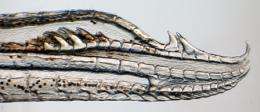A magnified view of the four hooked genitalia of the newly identified fish species Gambusia quadruncus. Credit: Brian Langerhans, NC State University
Fishing hooks aren't the only hooks found in east-central Mexican waters. A new species of freshwater fish described by a North Carolina State University researcher has several interesting – and perhaps cringe-inducing – characteristics, including a series of four hooks on the male genitalia.
Females of the new species – the llanos mosquitofish, or Gambusia quadruncus – also have distinguishing characteristics, including a colorful anal spot.
A paper describing the new species, which lives in a diversity hotspot and seemingly branched off from its closest relative more than one million years ago, appears in the Journal of Fish Biology.
Dr. Brian Langerhans, assistant professor of biology at NC State and the lead author of the paper, says that these interesting characteristics may play important roles in mating control and success.
While more research is needed, Langerhans says that four-hooked genitalia on males can serve a purpose when females attempt to block or restrict mating attempts.
This shows a male Gambusia quadruncus. Credit: Brian Langerhans, NC State University
"Typically, reproduction is more costly in females, so females favor ways of reducing mating with 'lower quality' males," Langerhans says, "but reproduction is cheap in males and so selection favors ways of mating with as many females as possible. In Gambusia, some females, including G. quadruncus, have evolved modifications that appear to function as a blocking device – essentially a big ball of tissue blocking most of the genital pore – restricting entry of the male's gonopodial tip. Thus, the female would have to behaviorally allow the male to mate or the male would have to evolve a counter response to avoid this problem."
The four-hooked genitalia could be that counter-response, Langerhans says.
"Having four hooks on the gonopodium may provide a means of overcoming female resistance, latching on to the gonopore and transferring sperm in a manner that facilitates effective sperm transfer. Or it may serve to stimulate the female in a manner that causes responses in the female that facilitate effective sperm transfer," Langerhans says.
Somewhat similarly, the colorful anal spot on females appears to serve as a signal that only certain males are desired for mating.
"The differing, species-specific female anal spots appear to influence male mating behavior by signaling the location of the gonopore to the male, sometimes indicating the reproductive status of the female, and distinguishing fish of their own species from fish of other species to reduce costly cross-breeding, which can result in fish with reduced fitness," Langerhans says. "So it may be that G. quadruncus evolved different anal spots to help reduce interspecies matings and possible formation of hybrids."
More information: Gambusia quadruncus (Cyprinodontiformes: Poeciliidae): A new species of mosquitofish from east-central Mexico, Brian Langerhans, North Carolina State University; et al, Online September 2012, in Journal of Fish Biology.
Abstract
Gambusia quadruncus n. sp., the llanos mosquitofish, is described from east-central Mexico. The region inhabited by the species represents a hotspot of diversity of Gambusia, and G. quadruncus sometimes coexists with at least three congeners. The species differs from its closest relative, Gambusia affinis, in several characteristics with plausible effects on reproductive isolation, e.g. body size, body and fin morphology, male genital morphology (distal tip of gonopodium) and female anal spot morphology (colouration near the urogenital sinus). Moreover, combined analysis of mitochondrial and nuclear gene sequence data (c. 2158 total base pairs) indicates reciprocal monophyly of G. quadruncus and its sister species G. affinis, with levels of genetic divergence suggesting the two species diverged from one another over a million years ago. The origin of G. quadruncus may reflect a vicariant event associated with Pliocene orogenesis in the Tamaulipas Arch and a frontal section of the Sierra Madre Oriental (Lleran Mesas). Gambusia quadruncus inhabits a variety of freshwater habitats across several river drainages, with its range spanning at least 350 km from north to south, covering over 25 000 km2. A key to aid identification of the species is provided.
Provided by North Carolina State University





















